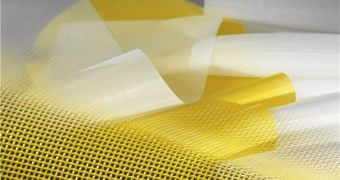Scientists at the Swiss Federal Laboratories for Materials Testing and Research (EMPA) announce the development of a new type of electrode, that could significantly boost the efficiency of solar cells.
The innovation is a response to the most recent demands on the market, which call for the development of transparent, flexible and electrically conductive electrode capable of harvesting and carrying away current inside thin-film solar cells.
According to scientists, the end goal of all this is to create moldable thin-film solar cells, that could be used to coat a variety of surfaces. But silicon – the material most often used nowadays to create solar cells – is not flexible, and cannot be used for these applications.
This is why the EMPA team developed the new electrodes. They are based on a type of polymer that can be woven, and which is therefore tremendously flexible. Early results obtained with the material are so good that experts believe the polymer may even replace indium tin oxide coatings in use today.
Such studies are especially important now when rare-Earth elements (REE), a class of chemicals that is indispensable to the creation of advanced electronics equipment including thin-film solar cells, are becoming increasingly difficult to obtain.
Other raw materials are also in low supplies, and so scientists are looking for alternative to use. Indium tin oxide (ITO), which is used in solar cells, is very expensive, and this drives the costs of the cells up, AlphaGalileo reports.
But replacing it with indium-free transparent oxides could make cell production faster and cheaper than ever before, analysts say. But these chemicals are becoming scarce too, and they do not solve one of the primary problems of solar cells, which is brittleness.
Conductive polymers, carbon nanotubes or graphene are just a few of the materials that are currently being investigated as possible replacements. But even they cannot function properly without flexible, yet stable conductive substrates.
A cost-effective material that can be used to create such a substrate is the new woven polymer electrode, the EMPA team says. The Swiss Commission for Technology and Innovation (CTI) funded the creation of the new material, which was developed together with Sefar AG.
The team now plans to improve on the new design, which currently sees the polymer being woven into a flexible plastic substrate. This allows the material to retain its conductivity when the substrate is bent.

 14 DAY TRIAL //
14 DAY TRIAL //